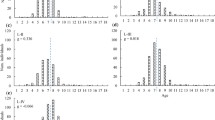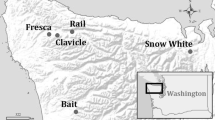Abstract
Key message
Radial growth responses of gap-edge trees to GT intensity greatly depends on microclimate condition (soil temperature and PAR) within gaps and their abilities in competing and utilizing the limited resources.
Abstract
Gap-model thinning (GT) is an effective management technique to improve the productivity of dense monoculture plantation. However, how GT intensity influence inter- and intra-annual radial growth of the gap-edge trees remains an open question. In order to explore this question, we implemented an experiment with four treatments (control and gap sizes of 74, 109, and 196 m2) in a 30-year-old spruce (Picea asperata) plantation in 2008. We used dendrochronological method to explore dynamic of the basal area increment (BAI) of gap-edge trees (n = 127) from 2009 to 2012 after GT treatments. We found that effects of GT on the BAI of gap-edge trees highly depended on GT intensity and their crown classes. The large gaps significantly increased the BAI of gap-edge trees and further the latewood growth responded more sensitively than the earlywood, whereas the influences of the small and intermediate gaps were weak; the large gaps effectively improved the BAI of the dominant trees, following by the intermediate, but not for the suppressed trees. Our results also displayed that the earlywood increment was strongly related to the soil temperature in spring and the latewood formation was influenced by the photosynthetically active radiation in autumn. It was eventually concluded that dynamic radial growth of gap-edge trees were driven by the improved microclimate caused by GT and their abilities in competing and utilizing resources. The present study highlights the importance of setting appropriate GT intensity and choosing the felled trees in GT operation.


Similar content being viewed by others
References
Arevalo JR, Fernandez-Palacios JM (2005) From pine plantations to natural stands. Ecological restoration of a Pinus canariensis Sweet, ex Spreng forest. Plant Ecol 181(2):217–226. doi:10.1007/s11258-005-6919-8
Arseneault JE, Saunders MR (2012) Incorporating canopy gap-induced growth responses into spatially implicit growth model projections. Ecol Model 237:120–131. doi:10.1016/j.ecolmodel.2012.04.003
Aussenac G (2000) Interactions between forest stands and microclimate: ecophysiological aspects and consequences for silviculture. Ann For Sci 57(3):287–301. doi:10.1051/forest:2000119
Barbour RJ, Fayle DCF, Chauret G, Cook J, Karsh MB, Ran SK (1994) Breast-height relative density and radial growth in mature Jack pine (Pinus banksiana) for 38 years after thinning. Can J For Res 24(12):2439–2447. doi:10.1139/x94-315
Begum S, Nakaba S, Yamagishi Y, Oribe Y, Funada R (2013) Regulation of cambial activity in relation to environmental conditions: understanding the role of temperature in wood formation of trees. Physiol Plant 147(1):46–54. doi:10.1111/j.1399-3054.2012.01663.x
Bevilacqua E, Puttock D, Blake T, Burgess D (2005) Long-term differential stem growth responses in mature eastern white pine following release from competition. Can J For Res 35(3):511–520. doi:10.1139/x04-198
Biondi F (1999) Comparing tree-ring chronologies and repeated timber inventories as forest monitoring tools. Ecol Appl 9(1):216–227. doi:10.1890/1051-0761(1999)009[0216:CTRCAR]2.0.CO;2
Bréda N, Granier A, Aussenac G (1995) Effects of thinning on soil and tree water relations, transpiration and growth in an oak forest (Quercus petraea (Matt.) Liebl.). Tree Physiol 15(5):295–306. doi:10.1093/treephys/15.5.295
Brown PL, Doley D, Keenan RJ (2004) Stem and crown dimensions as predictors of thinning responses in a crowded tropical rainforest plantation of Flindersia brayleyana R Muell. For Ecol Manag 196(2–3):379–392. doi:10.1016/j.foreco.2004.03.029
Canham CD, Denslow JS, Platt WJ, Runkle JR, Spies TA, White PS (1990) Light regimes beneath closed canopies and tree-fall gaps in temperate and tropical forests. Can J For Res 20(5):620–631. doi:10.1139/x90-084
Chen M, Zhu JJ, Yan QL, Wu XY, Tan H (2009) Comparison of light characteristics in different size gaps in eastern Liaoning montane secondary forests. Chin J Appl Ecol 19(12):2555–2560 (in Chinese)
Deslauriers A, Rossi S, Anfodillo T, Saracino A (2008) Cambial phenology, wood formation and temperature thresholds in two contrasting years at high altitude in southern Italy. Tree Physiol 28(6):863–871. doi:10.1093/treephys/28.6.863
D’Orangeville L, Cote B, Houle D, Morin H, Duchesne L (2013) A three-year increase in soil temperature and atmospheric N deposition has minor effects on the xylogenesis of mature balsam fir. Trees 27(6):1525–1536. doi:10.1007/s00468-013-0899-4
Gricar J, Zupancic M, Cufar K, Oven P (2007) Regular cambial activity and xylem and phloem formation in locally heated and cooled stem portions of Norway spruce. Wood Sci Technol 41(6):463–475. doi:10.1007/s00226-006-0109-2
Jiang YM, Pang XY, Bao WK (2011) Soil microbial biomass and the influencing factors under Pinus tabulaeformis and Picea asperata plantations in the upper Minjiang River. Acta Ecol Sinica 31(03):801–811 (in Chinese)
Jones TA, Thomas SC (2004) The time course of diameter increment responses to selection harvests in Acer saccharum. Can J For Res 34(7):1525–1533. doi:10.1139/x04-034
Jones TA, Thomas SC (2007) Leaf-level acclimation to gap creation in mature Acer saccharum trees. Tree Physiol 27(2):281–290. doi:10.1093/treephys/27.2.281
Jones TA, Domke GM, Thomas SC (2009) Canopy tree growth responses following selection harvest in seven species varying in shade tolerance. Can J For Res 39(2):430–440. doi:10.1139/x08-186
Jyske T, Holtta T, Makinen H, Nojd P, Lumme I, Spiecker H (2010) The effect of artificially induced drought on radial increment and wood properties of Norway spruce. Tree Physiol 30(1):103–115. doi:10.1093/treephys/tpp099
Klingsporn S, Webster CR, Bump JK (2012) Influence of legacy-tree retention on group-selection opening persistence. For Ecol Manag 286:121–128. doi:10.1016/j.foreco.2012.08.034
Koga S, Zhang SY, Begin J (2002) Effects of precommercial thinning on annual radial growth and wood density in balsam fir (Abies balsamea). Wood Fiber Sci 34(4):625–642
Latham P, Tappeiner J (2002) Response of old-growth conifers to reduction in stand density in western Oregon forests. Tree Physiol 22(2–3):137–146. doi:10.1093/treephys/22.2-3.137
Lebourgeois F (2000) Climatic signals in earlywood, latewood and total ring width of Corsican pine from western France. Ann For Sci 57(2):155–164. doi:10.1051/forest:2000166
Linares JC, Camarero JJ, Carreira JA (2009) Plastic responses of Abies pinsapo xylogenesis to drought and competition. Tree Physiol 29(12):1525–1536. doi:10.1093/treephys/tpp084
Lupi C, Morin H, Deslauriers A, Rossi S (2012) Xylogenesis in black spruce: does soil temperature matter? Tree Physiol 32(1):74–82. doi:10.1093/treephys/tpr132
Makinen H, Hynynen J (2012) Predicting wood and tracheid properties of Scots pine. For Ecol Manag 279:11–20. doi:10.1016/j.foreco.2012.05.024
Mäkinen H, Isomäki A (2004) Thinning intensity and long-term changes in increment and stem form of Norway spruce trees. For Ecol Manag 201(2–3):295–309. doi:10.1016/j.foreco.2004.07.017
Martín-Benito D, Cherubini P, del Río M, Cañellas I (2008) Growth response to climate and drought in Pinus nigra Arn. trees of different crown classes. Trees 22(3):363–373. doi:10.1007/s00468-007-0191-6
Martín-Benito D, Del Río M, Heinrich I, Helle G, Canellas I (2010) Response of climate-growth relationships and water use efficiency to thinning in a Pinus nigra afforestation. For Ecol Manag 259(5):967–975. doi:10.1016/j.foreco.2009.12.001
McDowell N, Brooks J, Fitzgerald S, Bond B (2003) Carbon isotope discrimination and growth response of old Pinus ponderosa trees to stand density reductions. Plant Cell Environ 26(4):631–644. doi:10.1046/j.1365-3040.2003.00999.x
McDowell NG, Adams HD, Bailey JD, Hess M, Kolb TE (2006) Homeostatic maintenance of ponderosa pine gas exchange in response to stand density changes. Ecol Appl 16(3):1164–1182. doi:10.1890/1051-0761(2006)016[1164:HMOPPG]2.0.CO;2
Neuendorff JK, Nagel LM, Webster CR, Janowiak MK (2007) Stand structure and composition in a northern hardwood forest after 40 years of single-tree selection. North J Appl For 24(3):197–202
Pang XY, Bao WK, Zhu B, Cheng WX (2013) Responses of soil respiration and its temperature sensitivity to thinning in a pine plantation. Agric For Meteorol 171–172:57–64. doi:10.1016/j.agrformet.2012.12.001
Pedersen BS, Howard JL (2004) The influence of canopy gaps on overstory tree and forest growth rates in a mature mixed-age, mixed-species forest. For Ecol Manag 196(2–3):351–366. doi:10.1016/j.foreco.2004.03.031
Perez-de-Lis G, Garcia-Gonzalez I, Rozas V, Arevalo JR (2011) Effects of thinning intensity on radial growth patterns and temperature sensitivity in Pinus canariensis afforestations on Tenerife Island, Spain. Ann For Sci 68(6):1093–1104. doi:10.1007/s13595-011-0125-8
Phillips DL, Shure DJ (1990) Patch-size effects on early succession in southern Appalachian forests. Ecology. doi:10.2307/1940260
Prevost M, Raymond P (2012) Effect of gap size, aspect and slope on available light and soil temperature after patch-selection cutting in yellow birch-conifer stands, Quebec, Canada. For Ecol Manag 274:210–221. doi:10.1016/j.foreco.2012.02.020
Ritter E (2005) Litter decomposition and nitrogen mineralization in newly formed gaps in a Danish beech (Fagus sylvatica) forest. Soil Biol Biochem 37(7):1237–1247. doi:10.1016/j.soilbio.2004.11.020
Rossi S, Deslauriers A, Anfodillo T, Carraro V (2007) Evidence of threshold temperatures for xylogenesis in conifers at high altitudes. Oecologia 152(1):1–12. doi:10.1007/s00442-006-0625-7
Rossi S, Morin H, Deslauriers A, Plourde P-Y (2011) Predicting xylem phenology in black spruce under climate warming. Glob Change Biol 17(1):614–625. doi:10.1111/j.1365-2486.2010.02191.x
Stan AB, Daniels LD (2010) Growth releases of three shade-tolerant species following canopy gap formation in old-growth forests. J Veg Sci 21(1):74–87. doi:10.1111/j.1654-1103.2009.01120.x
Tan H, Zhu JQ, Kang HZ, Zhang L (2007) A research review on forest gap disturbance. Chin J Ecol 26(4):587–594. doi:10.13292/j.1000-4890.2007.0107
Thiel AL, Perakis SS (2009) Nitrogen dynamics across silvicultural canopy gaps in young forests of western Oregon. For Ecol Manag 258(3):273–287. doi:10.1016/j.foreco.2009.04.015
Wardman CW, Schmidt MG (1998) Growth and form of Douglas-fir adjacent to persistent vine maple gaps in southwestern British Columbia. For Ecol Manag 106(2):223–233. doi:10.1016/S0378-1127(97)00315-0
Wyckoff PH, Clark JS (2005) Tree growth prediction using size and exposed crown area. Can J For Res 35(1):13–20. doi:10.1139/x04-142
Acknowledgments
The investigation was supported by the National Science and Technology Pillar program in 12th 5-year Plan of China (No. 2011BAC09B0402) and the Strategic Priority Research Program of the CAS (No. XDA05070306). We gratefully acknowledge Dr. Fanglan Li, Zhe Wang and Bin Yang for providing valuable comments on the manuscript.
Author information
Authors and Affiliations
Corresponding author
Ethics declarations
Conflict of interest
The authors declare that they have no conflict of interest.
Additional information
Communicated by T. Kajimoto.
Rights and permissions
About this article
Cite this article
Zhao, Q., Pang, X., Bao, W. et al. Effects of gap-model thinning intensity on the radial growth of gap-edge trees with distinct crown classes in a spruce plantation. Trees 29, 1861–1870 (2015). https://doi.org/10.1007/s00468-015-1267-3
Received:
Revised:
Accepted:
Published:
Issue Date:
DOI: https://doi.org/10.1007/s00468-015-1267-3




